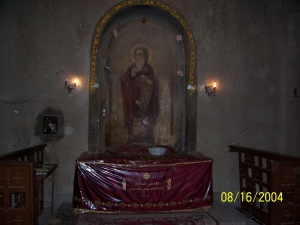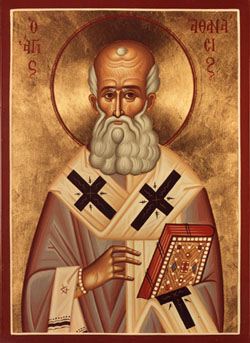Athanasius of Alexandria
Our father among the saints Athanasius of Alexandria (also spelled "Athanasios") was a bishop of Alexandria and major theological writer in the fourth century. He is also called Athanasius the Great. He was born in 298 and died on May 2, 373. His feast day in the Orthodox Church is January 18.
Life
Before reaching the age of 20, Athanasius wrote a treatise entitled On the Incarnation, affirming and explaining that Jesus Christ was both God and Man. In about 319, when Athanasius was a deacon, a presbyter named Arius began teaching that there was a time before God the Father begat Jesus when the latter did not exist. Athanasius responded that the Father's begetting of the Son, or uttering of the Word, was an eternal relationship between them, not an event that took place within time. Thus began catholic Christianity's fight against the heresy of Arianism.
Athanasius fought consistently against Arianism all his life. He accompanied Alexander of Alexandria to the First Council of Nicea in 325, which produced the Nicene Creed and anathematized Arius and his followers. He was the main author of the Nicene Creed, and therefore given the title of Defender of the Faith by the Church of Alexandria. On May 9, 328, he succeeded Alexander as bishop of Alexandria, becoming the 20th Patriarch of the Church of Alexandria. As a result of rises and falls in Arianism's influence, he was banished from Alexandria only to be later restored on at least five separate occasions, perhaps as many as seven. This gave rise to the expression Athanasius contra mundum or "Athanasius against the world". During some of his exiles, he spent time with the Desert Fathers, monks and hermits who lived in remote areas of Egypt.
Athanasius is also the first person to identify the same 27 books of the New Testament that are in use today; up until his Easter letter, various similar lists were in use. However, his list was the one that was eventually ratified by a series of synods and came to be universally recognized as the New Testament canon.
He also wrote a biography of Anthony the Great that later served as an inspiration to Christian monastics in both the East and the West. The Athanasian Creed is traditionally ascribed to him, though it is likely not his work.

The following is a troparion (hymn) to St. Athanasius sung in some Orthodox churches:
- O holy father Athanasius,
- like a pillar of orthodoxy
- you refuted the heretical nonsense of Arius
- by insisting that the Father and the Son are equal in essence.
- O venerable father, beg Christ our God to save our souls.
External links
Categories > Church History
Categories > Church History
Categories > Church History
Categories > Church History
Categories > Church History
Categories > Church History
Categories > Church History
Categories > Liturgics > Feasts
Categories > Liturgics > Feasts
Categories > Liturgics > Feasts
Categories > Liturgics > Feasts
Categories > Liturgics > Feasts
Categories > People > Clergy > Bishops
Categories > People > Clergy > Bishops
Categories > People > Clergy > Bishops > Bishops by century > 4th-century bishops
Categories > People > Clergy > Bishops > Bishops by city > Patriarchs of Alexandria
Categories > People > Saints
Categories > People > Saints > Byzantine Saints
Categories > People > Saints > Church Fathers
Categories > People > Saints > Church Fathers > Nicene and Post-Nicene Fathers
Categories > People > Saints > Saints by century > 4th-century saints
